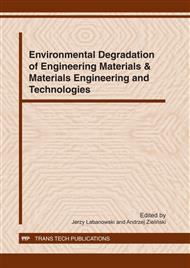[1]
Shape memory and superelastic alloys: Applications and technologies, (eds. ) K. Yamauchi, I. Ohkata, K. Tsuchiya, and S. Miyazaki, Woodhead Publishing Ltd., Cambridge, (2011).
DOI: 10.1533/9780857092625
Google Scholar
[2]
N.B. Morgan: Mater. Sci. Eng., A, Vol. 378 (2004) p.16.
Google Scholar
[3]
J. Khalil-Allafi, B. Amin-Ahmadi, M. Zare: Mater. Sci. Eng., C, Vol. 30 (2010), p.1112.
Google Scholar
[4]
C. Trepanier, R. Venugopalan, A.R. Pelton: Corrosion resistance and biocompatibility of passivated NiTi, in: Shape memory implants, L'H. Yahia (ed. ), California (2000).
DOI: 10.1007/978-3-642-59768-8_3
Google Scholar
[5]
S.A. Shabalovskaya: Bio-Med. Mater. Eng., Vol. 12 (2002), p.69.
Google Scholar
[6]
D. Sstarosvetsky, I. Gotman: Biomater., Vol. 22 (2001), p.1853.
Google Scholar
[7]
A. Michiardi, C. Aparicio, J.A. Planell, F.J. Gil: Surf. Coat. Technol., Vol. 201 (2007), p.6484.
Google Scholar
[8]
J. Lelątko, T. Goryczka, T. Wierzchoń, M. Ossowski, B. Łosiewicz, E. Rówiński, H. Morawiec: Solid State Phenom. Vol. 163 (2010), p.127.
DOI: 10.4028/www.scientific.net/ssp.163.127
Google Scholar
[9]
D. Yang, C. Liu, X. Liu, M. Qi, G. Lin: Cur. Appl. Phys., Vol. 5 (2005), p.417.
Google Scholar
[10]
J.A. Ruiz, I. Rosales, J.G. Gonzalez-Rodriguez, J. Uruchurtu: Int. J. Electrochem. Sci., Vol. 5 (2010), p.593.
Google Scholar
[11]
Impedance spectroscopy: theory, experiment, and applications, Evgenij Barsoukov, J. Ross Macdonald (Edts. ), Wiley-Interscience, A John Wiley & Sons. Inc., Hoboken, New Jersey, 2005, USA.
DOI: 10.1002/jrs.1558
Google Scholar
[12]
A. Lasia, Electrochemical impedance spectroscopy and its applications, in: Modern aspects of electrochemistry, Vol. 32, B.E. Conway, J. Bockris, and E.E. White (Edts. ), Kluwer Academic/Plenum Publishers, New York, (1999).
Google Scholar
[13]
AUTOLAB, Electrochemical instruments, Description of the instrument, Eco Chemie B.V., Kanaalweg, Utrecht, The Netherlands (1998).
Google Scholar
[14]
User manual for frequency response analysis (FRA) for Windows version 4. 9, Eco Chemie B.V., Kanaalweg, Utrecht, The Netherlands, (2001).
Google Scholar
[15]
B.A. Boukamp: Solid State Ionics, Vol. 20 (1986), p.31; Vol. 18-19 (1986), p.136.
Google Scholar
[16]
ASTM F2129-08: Standard test method for conducting cyclic potentiodynamic polarization measurements to determine the corrosion susceptibility of small implant devices.
DOI: 10.1520/f2129
Google Scholar
[17]
N. Figueira, T.M. Silva, M.J. Carmezim, J.C.S. Fernandes: Electrochim. Acta, Vol. 54 (2009), p.921.
Google Scholar


